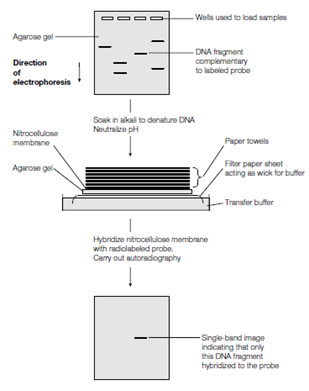Southern blotting:
Gel electrophoresis is broadly used to divide and size DNA molecules in during recombinant DNA experiments. After gel electrophoresis there is frequently a required to detect one or more DNA fragments containing a specific nucleotide sequence. This is simply carried out through Southern blotting. Following electrophoresis of the restriction fragments through an agarose gel the gel is flooded in alkali to denature the DNA to one strands and the pH is then neutralized. The gel is located in contact with a nitrocellulose or nylon membrane filter sheet arranged so that buffer flows by the gel and carries the DNA fragments to the membrane that was shown in the diagram. Membrane binds the single-stranded DNA and so the band pattern in the gel is now transferred to it. Membrane filter is peeled from the gel and baked at high temperature to fix the DNA to it and then incubated with a radiolabeled DNA probe. After the hybridization probe will have bound only to DNA fragments with complementary sequences. These can be visualized through washing away excess probe and then placing the filter against an X-ray film for autoradiography. The pictures produced on the autoradiogram specify those bands that contain the probe sequence.

Figure: Southern blotting. The procedure shown is the original method of Southern using capillary action to blot the DNA bands from the gel to the nitrocellulose membrane. Electrolytic transfer is now often used instead.